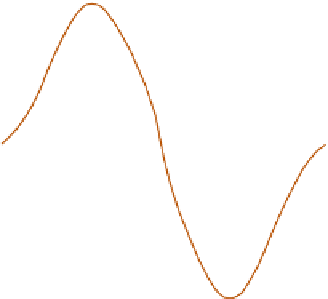Geoscience Reference
In-Depth Information
incoming and outgoing radiation. However,
observation shows that this is not so (
Figure 3.25
),
because, whereas incoming radiation varies
appreciably with changes in latitude, being highest
at the equator and declining to a minimum at
the poles, outgoing radiation has a more even
latitudinal distribution owing to the rather small
variations in atmospheric temperature. Some
other explanation therefore becomes necessary.
latent heat transport, which occurs almost wholly
in the lowest 2 or 3km, reflects the global wind
belts on either side of the subtropical high pressure
zones (see Chapter 8B). The more important
meridional transfer of sensible heat has a double
maximum not only latitudinally but also in the
vertical plane, where there are maxima near
the surface and at about 200mb. The high-level
transport is particularly significant over the
subtropics, whereas the primary latitudinal
maximum about 50
N is related to the
travelling low pressure systems of the westerlies.
°
to 60
°
1 The horizontal transport of heat
If the net radiation for the whole earth-
atmosphere system is calculated, it is found that
there is a positive budget between 35
150
(A)
N,
as shown in
Figure 3.26C
. The latitudinal belts in
each hemisphere separating the zones of positive
and negative net radiation budgets oscillate
dramatically with season (
Figure 3.26A
and
B
). As
the tropics do not get progressively hotter or the
high latitudes colder, a redistribution of world
heat energy must occur constantly, taking the
form of a continuous movement of energy from
the tropics to the poles. In this way, the tropics
shed their excess heat and the poles, being global
heat sinks, are not allowed to reach extremes of
cold. If there were no meridional interchange of
heat, a radiation balance at each latitude would be
achieved only if the equator were 14
°
S and 40
°
100
NET RADIATION BALANCE
OF THE EARTH'S SURFACE
50
0
NET RADIATION BALANCE
EARTH-ATMOSPHERE SYSTEM
-50
-100
NET RADIATION BALANCE OF THE ATMOSPHERE
5
(B)
4
3
2
1
0
1
C warmer
and the North Pole 25°C colder than at present.
This poleward heat transport takes place within
the atmosphere and oceans, and it is estimated
that the former accounts for approximately two-
thirds of the required total. The horizontal
transport (
advection
of heat) occurs in the form of
both latent heat (that is, water vapor, which
subsequently condenses) and sensible heat (that is,
warm air masses). It varies in intensity according
to the latitude and the season.
Figure 3.27B
shows
the mean annual pattern of energy transfer by
the three mechanisms. The latitudinal zone of
maximum total transfer rate is found between
latitudes 35° and 45° in both hemispheres,
although the patterns for the individual compo-
nents are quite different from one another. The
°
N
2
3
4
5
6
90°N
60°
30°
0°
Latitude
30°
60°
90°S
Figure 3.27
A: Net radiation balance for the earth's
surface of 101W m
-2
(incoming solar radiation of
156W m
-2
, minus outgoing longwave energy to the
atmosphere of 55W m
-2
); for the atmosphere of
-101W m
-2
(incoming solar radiation of 84W m
-2
,
minus outgoing longwave energy to space of 185W
m
-2
); and for the whole earth-atmosphere system of
zero. B: The average annual latitudinal distribution of
the components of the poleward energy transfer (in
10
15
W) in the earth-atmosphere system.
Source: From Sellers (1965). Courtesy of University of
Chicago Press.





































